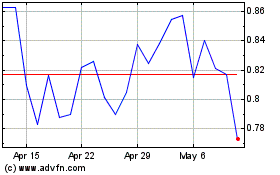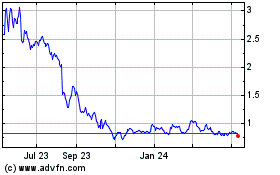- Overall renal responses (ORR), measured as 50% or greater
reduction in proteinuria from baseline, increased from 11 of 17
patients (64.7%) at end of treatment (Week 25) to 15 of 17 patients
(88.2%) at end of study (Week 37). The median UPCR at end of study
was 0.32.
- Reduction in proteinuria was highly correlated with reduction
in uCD163, a marker of renal inflammation. The anti-inflammatory
activity was maintained up to 12 weeks following discontinuation of
zetomipzomib as evidenced by additional reduction in proteinuria
and slow recrudescence of SLE disease activity.
- Systemic lupus erythematosus disease activity scores including
SLEDAI-2K and CLASI were reduced.
- Zetomipzomib once-weekly continues to demonstrate a favorable
safety and tolerability profile, with no evidence of
immunosuppression, and no new safety signals during the follow-up
period.
Kezar Life Sciences, Inc. (Nasdaq: KZR), a clinical-stage
biotechnology company discovering and developing breakthrough
treatments for immune-mediated and oncologic disorders, today
announced that it presented the complete data set from the MISSION
Phase 2 clinical trial evaluating zetomipzomib in active lupus
nephritis (LN) at the American College of Rheumatology (ACR)
Convergence 2022 in Philadelphia, PA.
“The MISSION Phase 2 results demonstrate the potential of
zetomipzomib, a first-in-class, selective inhibitor of the
immunoproteasome, to meaningfully reduce proteinuria, as well as
reduce extra-renal manifestations of systemic lupus in patients
with LN. By the end of study, the median UPCR was less than 0.5, a
clinically important treatment goal. Additionally, the data showed
improvements in the skin manifestations of lupus and patient
reported outcomes of disease. Importantly, these benefits were
accompanied by an overall reduction in the use of corticosteroids,”
said Noreen R. Henig, M.D., Kezar’s Chief Medical Officer.
“With a well-tolerated safety profile, anti-inflammatory activity,
and without indications of suppressing the immune system,
zetomipzomib is positioned to be a potentially important therapy
for patients with LN and SLE, as well as other autoimmune diseases
such as autoimmune hepatitis.”
The MISSION Phase 2 clinical trial was an open-label study
designed to demonstrate the responder rate of zetomipzomib in
patients with active LN. During the 24-week treatment period,
patients received 60 mg of zetomipzomib subcutaneously once weekly
(first dose of 30 mg) in addition to stable background therapy.
End-of-treatment (EOT) assessments occurred at Week 25, with
completion of the study at Week 37 (EOS). Patients in the MISSION
Phase 2 clinical trial received zetomipzomib without induction
therapy, which represents a significant difference from other
recently published clinical trials in LN. The primary efficacy
endpoint for this trial was the proportion of patients achieving an
overall renal response (ORR), measured as a 50% or greater
reduction in urine protein to creatinine ratio (UPCR) at EOT. A key
secondary efficacy endpoint was the number of patients with a
complete renal response (CRR), measured as an absolute reduction in
proteinuria values to a UPCR of 0.5 or less, with preserved renal
function (eGFR), and corticosteroid use of 10 mg or less
prednisone/prednisone equivalent and no use of prohibited
medication. Exploratory endpoints included measures of systemic
lupus erythematosus (SLE) disease activity, including Systemic
Lupus Erythematosus Disease Activity Index 2000 (SLEDAI-2K),
Cutaneous Lupus Erythematosus Severity Index-Activity (CLASI-A),
Physician Global Assessment and Patient Global Assessment
scores.
Summary of Results from the Completed
MISSION Trial
In the MISSION Phase 2 clinical trial, 17 of 21 enrolled
patients reached end-of-treatment at Week 25 and end-of-study at
Week 37. Zetomipzomib treatment demonstrated steady and clinically
meaningful renal responses with additional ORRs and CRRs observed
during the safety follow-up period.
- Overall Renal Responses:
- 10 out 17 patients (58.8%) achieved an ORR as early as Week
13.
- At EOT, 11 of 17 patients (64.7%) achieved an ORR, measured as
a 50% or greater reduction in UPCR compared to baseline, the
primary endpoint of the clinical trial.
- During the safety follow-up period, clinical responses
deepened, and ORRs increased to 16 of 17 patients (94.1%) at Week
29 and 15 of 17 patients (88.2%) at EOS. In addition, UPCR was
reduced to clinically meaningful levels:
- 11 of 17 patients (64.7%) achieved a UPCR of 0.5 or less at
EOS.
- 15 of 17 patients (88.2%) achieved a UPCR of 0.7 or less at
EOS.
- Median UPCR was 0.32 at EOS.
- Complete Renal Responses:
- 5 out 17 patients (29.4%) achieved a CRR as early as Week
13.
- At EOT, 6 of 17 patients (35.3%) achieved a CRR, a key
secondary efficacy endpoint, measured as a UPCR of 0.5 or less,
stable eGFR, daily prednisone/prednisone equivalent dose of 10 mg
or less, and no use of prohibited medication.
- During the safety follow-up period, an additional patient
achieved a CRR, with the total CRRs increasing to 7 of 17 patients
(41.2%) at Week 29 and EOS, demonstrating a deepening renal
response throughout the 37-week trial.
- Urinary CD163, a biomarker that is associated with active
inflammation in the kidney, decreased and showed a strong
correlation to UPCR across all timepoints in the study. These data
suggest that patients had active inflammation at baseline despite
standard-of-care therapy and that the addition of zetomipzomib
reduced inflammation.
- By Week 13, 14 of 17 patients (82.4%) achieved a daily
corticosteroid dose of 10 mg or less, despite no protocol-mandated
steroid taper. Doses of background immunosuppressive agents
remained stable throughout the study, including during the 12-week
safety follow-up.
- Key measurements of SLE disease activity were reduced. There
was no evidence of early rebound of inflammation following
discontinuation of zetomipzomib.
- SLEDAI-2K, a global assessment of SLE disease activity, reduced
from a mean of 11.3 at baseline to 6.5 at EOT and 5.8 at EOS.
- CLASI-A, a measure of active SLE skin disease, was elevated in
11 patients at baseline, and was reduced from a mean of 5.7 at
baseline to 2.6 at EOT and 3.0 at EOS.
- Physician Global Assessment scores reduced from a mean of 57.2
at baseline to 23.9 at EOT and 16.2 at EOS.
- Patient Global Assessment scores reduced from a mean of 23.6 at
baseline to 10.7 at EOT and 6.6 at EOS.
- Biomarkers of SLE activity improved or normalized in patients
with abnormal baseline levels.
- Of the 12 patients with abnormal levels of double-stranded DNA
antibody levels (anti-dsDNA) at baseline, 10 patients showed
improved or normalized levels of anti-dsDNA at EOT, and improvement
was maintained in 9 patients at EOS.
- 4 of 5 patients with abnormally low C3 complement at baseline
demonstrated improvement at EOT. 3 of 4 patients with abnormally
low C4 complement at baseline demonstrated improvement at EOT.
Safety
Zetomipzomib continued to be well-tolerated over the course of
the 37-week trial, demonstrating a favorable safety and
tolerability profile with no new safety signals during the
follow-up period. Overall, adverse events were generally
mild-to-moderate (Grade 1 or 2) and were consistent with what was
previously reported with topline data from the MISSION Phase 2
clinical trial. Early terminations occurred in 4 out of 21
patients. No opportunistic or Grade 3 infections were reported in
the trial.
Poster Presentation
Details:
Abstract Title: Interim Results from the Phase 2 MISSION
Study Evaluating Zetomipzomib (KZR-616), a First-in-Class Selective
Immunoproteasome Inhibitor for the Treatment of Lupus Nephritis
Session: SLE – Treatment Poster II Date/Time:
November 13, 2022 from 9:00 AM - 10:30 AM ET Presenter: Amit
Saxena, MD, Assistant Professor, NYU Grossman School of
Medicine
The MISSION poster presentation is currently
available in the “Scientific Publications” section of Kezar Life
Science’s website at www.kezarlifesciences.com.
About Zetomipzomib
Zetomipzomib (KZR-616) is a novel, first-in-class, selective
immunoproteasome inhibitor with broad therapeutic potential across
multiple autoimmune diseases. Preclinical research demonstrates
that selective immunoproteasome inhibition results in a broad
anti-inflammatory response in animal models of several autoimmune
diseases, while avoiding immunosuppression. Data generated from
Phase 1 and Phase 2 clinical trials provide evidence that
zetomipzomib exhibits a favorable safety and tolerability profile
for development in severe, chronic autoimmune diseases.
About Lupus Nephritis
Lupus nephritis (LN) is one of the most serious complications of
systemic lupus erythematosus (SLE). LN is a disease comprising a
spectrum of vascular, glomerular and tubulointerstitial lesions and
develops in approximately 50% of SLE patients within 10 years of
their initial diagnosis. LN is associated with considerable
morbidity, including an increased risk of end-stage renal disease
requiring dialysis or renal transplantation and an increased risk
of death. There are limited approved therapies for the treatment of
LN. Management typically consists of induction therapy to achieve
remission and long-term maintenance therapy to prevent relapse.
About Kezar Life Sciences
Kezar Life Sciences is a clinical-stage biopharmaceutical
company discovering and developing novel treatments for
immune-mediated and oncologic disorders. The company is pioneering
first-in-class, small-molecule therapies that harness master
regulators of cellular function to inhibit multiple drivers of
disease via single, powerful targets. Zetomipzomib, its lead
development asset, is a selective immunoproteasome inhibitor has
completed a Phase 2 clinical trial in lupus nephritis. This product
candidate also has the potential to address multiple chronic
immune-mediated diseases. KZR-261 is the first anti-cancer clinical
candidate from the company’s platform targeting the Sec61
translocon and the protein secretion pathway. An open-label
dose-escalation Phase 1 clinical trial of KZR-261 to assess safety,
tolerability and preliminary tumor activity in solid tumors is
underway. For more information, visit www.kezarlifesciences.com.
Cautionary Note on Forward-looking Statements
This press release contains forward-looking statements within
the meaning of the Private Securities Litigation Reform Act of
1995. Words such as “may,” “will,” “can,” “should,” “expect,”
“believe”, “potential,” “plan” and similar expressions (as well as
other words or expressions referencing future events, conditions or
circumstances) are intended to identify forward-looking statements.
These forward-looking statements are based on Kezar’s expectations
and assumptions as of the date of this press release. Each of these
forward-looking statements involves risks and uncertainties that
could cause Kezar’s clinical development programs, future results
or performance to differ materially from those expressed or implied
by the forward-looking statements. Forward-looking statements
contained in this press release include, but are not limited to,
statements about the design, progress, timing, scope and results of
clinical trials, the anticipated therapeutic benefit, regulatory
development and future clinical trials involving zetomipzomib, the
likelihood that data will support future development and
therapeutic potential, the association of data with treatment
outcomes and the likelihood of obtaining regulatory approval of
zetomipzomib. Many factors may cause differences between current
expectations and actual results, including unexpected safety or
efficacy data observed during clinical studies, changes in expected
or existing competition, the uncertainties and timing of the
regulatory approval process, and unexpected litigation or other
disputes. Other factors that may cause actual results to differ
from those expressed or implied in the forward-looking statements
in this press release are discussed in Kezar’s filings with the
U.S. Securities and Exchange Commission, including the “Risk
Factors” contained therein. Except as required by law, Kezar
assumes no obligation to update any forward-looking statements
contained herein to reflect any change in expectations, even as new
information becomes available.
View source
version on businesswire.com: https://www.businesswire.com/news/home/20221114005379/en/
Investors: Gitanjali Jain Vice President,
Investor Relations and External Affairs gjain@kezarbio.com
Media: Julia Deutsch Solebury Strategic
Communications jdeutsch@soleburystrat.com
Kezar Life Sciences (NASDAQ:KZR)
Historical Stock Chart
From Mar 2024 to Apr 2024

Kezar Life Sciences (NASDAQ:KZR)
Historical Stock Chart
From Apr 2023 to Apr 2024
